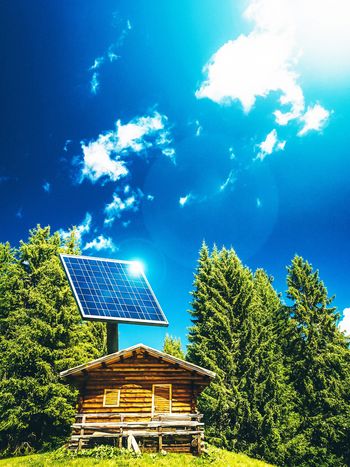Power system technical performance
by Zia Emin, Chairman & Genevieve Lietz, Secretary
Overview of Study Committee C4
Study Committee (SC) C4’s main mission is to facilitate and promote the progress of power systems engineering and the international exchange of information and knowledge in the field of system technical performance and to add value to this information and knowledge by means of gathering state-of-the-art practices from around the world and developing recommendations. The main approach is through the formation of working groups (WGs) and the publication of CIGRE technical brochures; some recent examples are provided at the end of this brief report. The other approach is through sponsoring and promoting colloquia around the world which focus on the key technical challenges in modern power systems that relate to system technical performance.
The scope of SC C4 is the development and review of methods and tools for analysis related to power systems, with particular reference to dynamic and transient conditions and to the interaction between the power system and each of the following:
- its apparatus/sub-systems;
- external causes of stress;
- and other installations.
Specific issues related to the design and manufacturing of components and apparatus are not within the scope of SC C4, nor are those specifically related to planning, operation and control, apart from cases in which a component, apparatus, or subsystem behaviour depends on, or significantly interacts with, the performance of the nearby power system.
The SC C4 scope covers system technical performance phenomena that range from nanoseconds to hours, which includes everything from lightning, switching, power quality, electromagnetic compatibility and electromagnetic interference (EMC/EMI) and insulation coordination to power system stability, modelling and long-term system dynamics.
As the scope is quite broad and covers all aspects of the technical performance of large power systems, further work was carried out to better explain the timeframe of various phenomena. This work is nearing its completion and the timeframes of various phenomena are given in Figure 1. The output of this work will be included as an appendix in the SC C4 strategic plan.
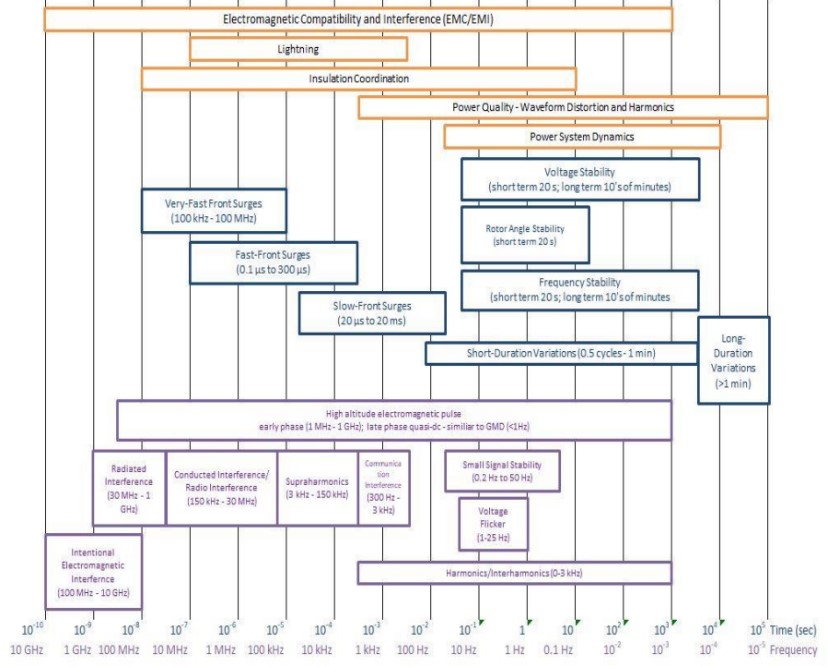
Figure 1 - Range of phenomena investigated by SC C4
Due to its wide remit SC C4 alone cannot investigate power system technical performance issues without a solid understanding of the equipment itself, its performance, system planning and operational issues and environmental factors that may play a role in system performance. This leads to close cooperation between SC C4 and other CIGRE SCs that deal with equipment, system planning and operations, distribution networks, materials and testing, and environmental aspects of the power system. The close cooperation can be seen from the establishment of several joint working groups (JWGs). Furthermore, nomination and establishment of liaison members from other SCs in SC C4’s WGs and vice versa also adds to the close collaboration between SC C4 and other SCs. At the time of writing, there are 12 JWGs with SCs A1, A2, A3, B1, B2, B4, B5, C1 and C2. Furthermore, two SC C4 WGs are joint with CIRED on issues related to distribution networks. There is also a JWG between SC C2 and IEEE owing to the increasing cooperation between the two organisations. SC C4 also has formal liaisons with the IEC TC 77 (on EMC) and the International Special Committee on Radio Interference (CISPR).
SC C4 Structure and strategic direction
SC C4 is composed of 24 regular members, 3 additional regular member and 18 observer members, together with a chairman and a secretary representing 42 countries. SC C4 presently consists of some 32 WGs performing highly technical work aligned with the strategic fields of SC C4. These WGs are composed of over six hundred individual technical experts from 50+ countries around the world, some serving in more than one WG.
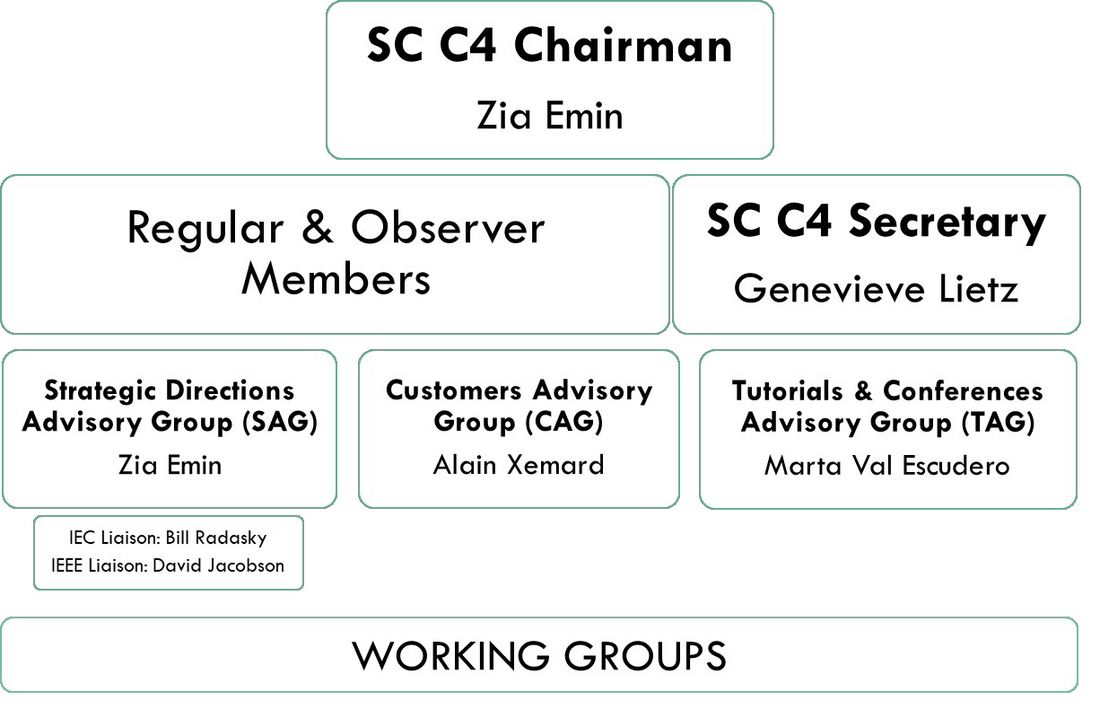
There are also three Advisory Groups (AGs) within SC C4. AG C4.1 is a group of experts that consults on the strategic directions for SC C4 and it includes liaisons with IEC and IEEE. AG C4.2 on Customers reviews and prioritises the composition of target groups and identifies improvements and opportunities for communication of the SC target groups. AG C4.3 on Tutorials and Conferences coordinates SC C4’s activities with respect to colloquia and tutorials.

Some of the participants (24 out of 45 individuals present) from the 2020 online meeting of SC C4.
Main technical areas of activity in SC C4
Below is a brief summary of WG activities in the main technical directions within SC C4.
Power quality
Currently there are four WGs concentrating on power quality related issues of present and future power systems. Work in most of the WGs is at an advanced stage. The WG C4.42 is looking at the important issue of low-order harmonic emissions from loads considering the changing load characteristics due to an increasing penetration of power electronic based loads. The aims of the work are: (i) to review current industry practice and new technologies and approaches available in this field; and (ii) to propose practical guidelines for online monitoring and continuous assessment of low-order harmonic emissions from customer installations. The work of WG C4.40 is closely related and equally important in this area as it is trying to revise the relevant IEC Technical Reports, i.e. IEC 61000-3-6, 61000-3-7, 61000-3-13 and 61000-3-14. WG C4.42 is nearing its completion.
The other two WGs within this technical direction include C4.49 looking at multi-frequency instabilities of grid-tied converter based modern power systems crossing both stability and power quality analysis areas; and C4.51 looking at traction supply points and the impact these points may have on the wider system with respect to power quality.
Electromagnetic Compatibility and Electromagnetic Interference (EMC/EMI)
Electromagnetic Compatibility and Electromagnetic Interference (EMC/EMI) issues addressed by SC C4 cover emission and immunity problems resulting from disturbances that are not addressed under the subject of power quality. These include disturbances produced by the electrical power system as well as disturbances of external origin able to interfere with the electrical power system. Such disturbances can affect the integrated system performance by electrical conduction (electrical contact), induction (electric or magnetic fields) or radiation (high-frequency electromagnetic field). Health effects related to low-frequency electromagnetic field (EMF) are excluded, whilst intentional electromagnetic interference (IEMI) is instead included.
There are three active WGs within SC C4 that can be classified as being related to EMC. WG C4.44 is focusing on EMC for large photovoltaic systems and its work is at an advanced stage. Two further WGs include C4.54, which is looking at the protection of HV power network control electronics from the high-altitude electromagnetic pulse (HEMP), and C4.55, which is examining EMC related very-fast transients in gas-insulated substations Work is on track in both of these WGs.
Insulation coordination
There are seven active WGs within the technical direction of insulation coordination. Two WGs concentrate on overvoltage related issues: JWG B4/B1/C4.73 on the surge and extended overvoltage testing of HVDC cable systems with a goal to produce recommendations on methods for determining lightning levels in mixed OHL-cable systems; and WG C4.46 on the evaluation of temporary overvoltages. WG C4.48 on the other hand is trying to formulate overvoltage withstand characteristics of power system equipment from 35 to 1200kV. These are complemented by JWG B1/C4.69 looking specifically to address the development of insulation coordination recommendations on AC cable systems. Two well-advanced WGs includeC4.45, which is looking at measurement techniques and characteristics of fast and very fast transient overvoltages in substations and converter stations; and C4.50, which is investigating the evaluation of transient performance of grounding systems in substations. JWG C4/A3.53 is looking at the application of advanced metal-oxide varistors for surge arresters with better protection properties.
Lightning
Lightning is one of the most important natural phenomena that impacts and interacts with the electric power network necessitating advanced knowledge of lighting current parameters. There are presently seven WGs investigating various aspects of lightning. Substantial testing and analysis are being addressed in WG C4.23 which is formulating a guide to procedures for estimating lightning performance of transmission lines and the work is almost complete. Two further WGs, C4.36 and C4.39 are looking at lightning parameters and engineering consequences for wind turbines and effectiveness of line surge arresters for lightning protection of OHLs respectively; both WGs are nearing completion. WG C4.43 is well advanced in its work reviewing lightning protection design schemes for structures from the viewpoint of avoiding physical damage and overvoltages that could generate flashover at electric apparatus and lines, and investigating the applicability of these schemes to nuclear power plants. Two other WGs include WG C4.57, which is looking specifically at formulating guidelines for the estimation of lightning performance of distribution lines; and JWG B2/C4.76, which is concentrating on lightning and grounding considerations during rebuilding or refurbishment of overhead lines for both AC and DC. The most recent WG C4.59 is addressing real-time lightning protection in relation to the networks of the future where digitisation is heavily in use.
Power systems dynamic performance models and numerical analysis
The subject of system dynamics and the overall system performance in terms of various stability parameters is gaining significant attention in the face of increased connection of power electronic based devices. This trend is obvious from the number of WGs within this technical direction with a total of eleven WGs looking at many important issues of present and future concerns for power system dynamics and analysis. These include subjects such as:
- Impact of Low Inertia Network on Protection and Control (JWG B5/C4.61)
- Impact of High Penetration of Inverter-based Generation on System Inertia of Networks (JWG C2/C4.41)
- Guidelines for Sub-synchronous Oscillation Studies in Power Electronics Dominated Power Systems (JWG C4/B4.52)
- Electromagnetic Transient Simulation Models for Large-Scale System Impact Studies in Power Systems having a High Penetration of Inverter Connected Generation (WG C4.56)
- Evaluation of Voltage Stability Assessment Methodologies in Transmission Systems (JWG C4/C2.58/IEEE)
These WGs, and several others that are at a more advanced stage, are investigating challenging technical issues associated with modelling, simulation and dynamic performance assessment of power systems around the world. The ever-increasing penetration of renewable energy sources as part of the generation mix is driving the formation of more WGs in this area due to the need to understand the level of technical performance issues facing the grid of the future.
Newly formed Working Groups
One new WG has been established since October 2019:
- WG C4.59 “Real-time Lightning Protection of the Electricity Supply Systems of the Future”.
SC C4 has traditionally established around five to six new WGs per annum over the past several years. However, the number of the existing WGs completing their mandate has been delayed due to current pandemic related effects and hence the impetus to form new WGs has been affected as a result.
There is currently one newly proposed WG under evaluation. However, during the 2020 annual SAG and SC meetings, it was decided to put together a list of areas that require further consideration and possible new WGs. This work is in progress and expected to complete its review within 2020.

CIGRE active Working Groups / Call for experts
Publications
Technical Brochures
The following Technical Brochures have been published since October 2019 as a result of work done by SC C4 WGs and JWGs:
At least three further technical brochures are expected to be finalised and submitted to the SC before the end of 2020:
- JWG C4.42/CIRED “Continuous Assessment of Low-Order Harmonic Emissions from Customer Installations”;
- WG C4.36 “Winter Lightning – Parameters and Engineering Consequences for Wind Turbines”; and
- JWG C4/B5.41 “Challenges with Series Compensation Application in Power Systems when Overcompensating Lines”.
Reference Papers
SC C4 has produced three reference papers (in collaboration with the associated WGs) since October 2019:
All reference papers had an accompanying article in the Future Connections Newsletter published by the Technical Council. The latter two reference papers also had a longer paper published in the CIGRE Science & Engineering journal. Furthermore, WG C4.47 has also produced an updated definition of power system resilience following the pandemic where the effect is examined and the update appeared in the Leadership Circle, the newsletter targeted at senior management within the power system industry.
Green Books
SC C4 supported the Future Power Systems Green Book with a chapter of its own. A group of SC C4 experts provided the main material which was the edited by the Chair and Secretary of the SC. The content of the chapter is based on the five main technical directions of the SC. The main contributors to the SC C4 chapter were in (alphabetical order): Claus Leth Bak (Aalborg University), John van Coller (University of the Witwatersrand), Gerhard Diendorfer (OVE), Vic Gosbell (University of Wollongong), Liisa Haarla (Fingrid), Andrew Halley (TasNetworks), David Jacobson (Manitoba Hydro), Stephan Pack (Technical University of Graz), Sarath Perera (University of Wollongong) , WH Siew (University of Strathclyde), Wolfgang Schulz (OVE), Filipe Faria da Silva (Aalborg University) and Ivo Uglesic (University of Zagreb).

The Green Book is available for purchase on our partner's website Springer.
If you are a CIGRE Member, please contact us to benefit from a 40% discount on your purchase.
Tutorials and Conferences
Since October 2019, SC C4 has supported the following events:
CIGRE SC C4 International Colloquium on Lightning and Power Systems, October 2019, Delft, Netherlands
In collaboration with the Delft University of Technology, Power System Protection Centre and the Dutch National Committee of CIGRE under the leadership of Marjan Popov (Netherlands). As part of the colloquium, three tutorials were delivered:
- “Impact of Soil-Parameter Frequency Dependence on the Response of Grounding Electrodes and on the Lightning Performance of Electrical Systems”, provided by Silverio Visacro (Brazil) of WG C4.33;
- “Winter Lightning - its Characteristics and Interaction with Objects on Ground”, provided by Masaru Ishii (Japan) of WG C4.36; and
- “Electromagnetic Computation Methods for Lightning Surge Studies with Emphasis on the FDTD Method”, provided by Yoshihiro Baba (Japan) and Akiyoshi Tatematsu (Japan) of WG C4.37.
CIGRE 2020 e-Session which replaced the 2020 bi-annual session.
As part of the e-Session SC C4 had four paper sessions run over two days, a tutorial and a workshop:
- The paper sessions were moderated by David Jacobson (Canada) and Filipe Faria da Silva (Denmark) who were also the Special Reporters and were supported by Marta Val Escudero;
- The tutorial entitled “Power System Test Cases for EMT-Type Simulation Studies” was based on the work done WG C4.503 and was presented by Jean Mahseredjian (Canada) and Aboutaleb Haddadi (Canada); and
- The Workshop on “System Strength - A story about not enough shepherds and too many sheep” was organised by Andrew Halley (Australia) and Babak Badrzadeh (Australia) with presenters from a few different sectors and countries.
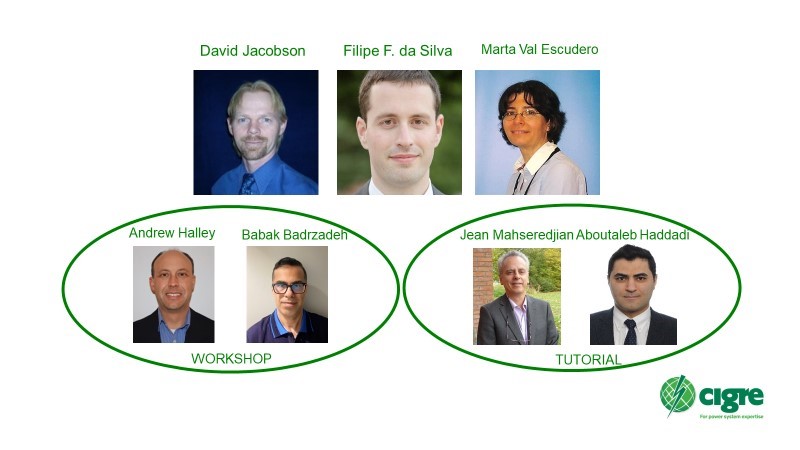
Individuals that supported SC C4 2020 e-Session
In terms of upcoming events supported by SC C4, the International Colloquium on Lightning and Power Systems planned to take place in Suzhou, China in March 2021 has been cancelled and to the possibility of holding the next colloquium there tentatively in 2023 is still under discussion.
The next major event to be supported by SC C4 will the Paris 2021 Centennial Session followed by the Kyoto Symposium in April 2022.
Awards
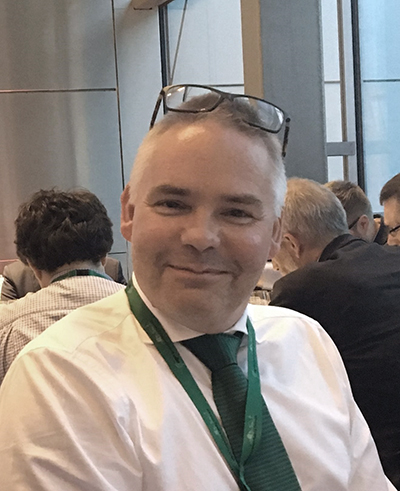
SC C4 Technical Council award winner Claus Leth Bak
The following individuals associated with SC C4 work in the past or currently (some members work across SCs) were recognised with various CIGRE Awards:
- Pouyan Pourbeik (US), Maks Babuder (SI) and D K Chaturverdi (IN) were awarded with CIGRE Fellowship;
- Claus Leth Bak (DK) with Technical Council Award;
- Alex Baitch (AUS), Jinliang He (CN), Claus Leth Bak (DK), Marta Val Escudero (IE), Hideki Motoyama (JP), Eiichi Zaima (JP), Igor Papic (SI), Robert Koch (ZA) and Nicholas Miller (US) were all awarded with the CIGRE Distinguished Member Award.

